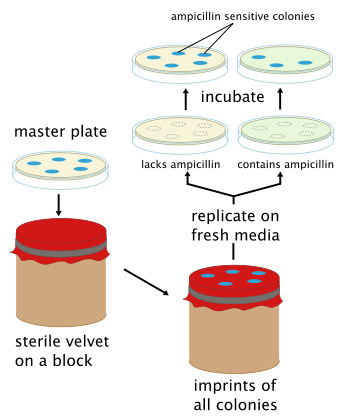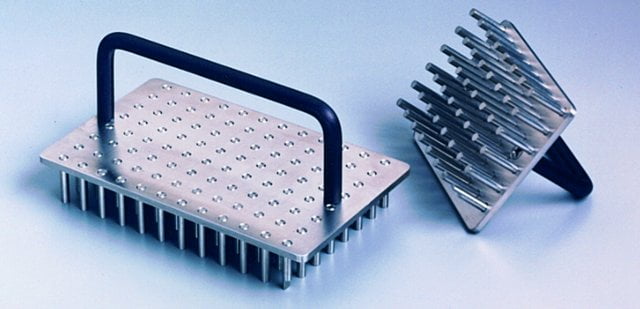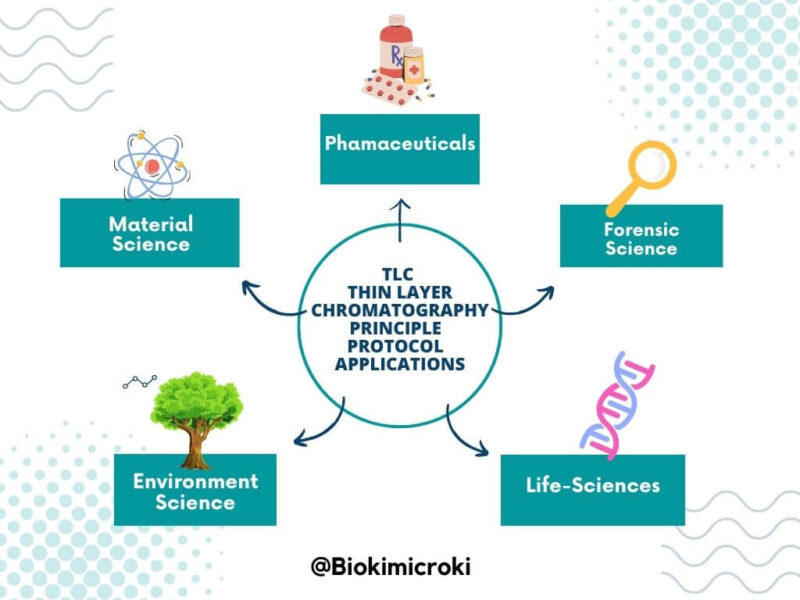As the name suggest, this technique is used to make replica or copy of the master plate (Primary plate). This technique is originated in Microbiology and now it is also used in Animal Cell Culture techniques. This technique was developed by Joshua and Esther Lederberg in 1952. The application of Replica plating is to reproduce identical spatial colonies pattern in new plate. It is also used for isolation of genetic variant or antibiotic resistant. This can be done by comparing the master or primary plate with the secondary one.
Replicate Plating in Microbiology –
The Replica plating technique works on Negative selection principle. Suppose, you have a master plate in which antibiotic sensitive and antibiotic resistant bacteria are cultures. As a researcher, you wish to find the antibiotic sensitive bacterial strains. To do this you need to follow the following protocol –
- You need mount a small sterile velvet cloth on a cylindrical metallic or wooden block. The cloth should be stretched with downward pressure and locked it with locking ring.
- The block size should be a bit smaller than petri plate size.
- Mark a spot on the circumference of master plate referring the position of the lock of locking ring. This spot is called as reference point. This would allow us the understand orientation of colonies.
- Place the velvet side of the block on your master plate (with antibiotic sensitive and resistant strain).
- Invert your master plate and gently press against the velvet. The bacteria from different colonies will cling or adhere on the fibers of the velvet cloth. Hence, acting like an inoculating needle.
- Remove the velvet cloth cylindrical block from master plate and place it in fresh sterile media with antibiotic (secondary plate). Save the master plate.
- Keep the secondary plate for incubation. The location of colonies would be identical to the primary one.
- After incubation, you would observe that only antibiotic resistant bacteria are able to grow in the secondary plate.
- Comparing both the plate, you will be able to find the colonies of antibiotic sensitive strain. As the antibiotic plate does not select or allow the antibiotic sensitive strains to grow, it is called as negative selection.

Replica plating in Animal Cell Culture –
- The protocol remains the same. But while replicating animal cells plate, replicator device can be used in place of wooden block. The Replicator is used specially for animal cells cultured in micro test plate. The replicator is made of aluminum plate and consists of 60 holes exactly matching to the micro test plate.
- Each hole of replicator contains stainless steel pin (bolt) with groove at the tip. These groves increases the capillary action of the pins.
- Before using replicator, the cultured animal cells in micro test plate (Master Plate) is treated with 1mL of trypsin-EDTA in order to loosen and get detached from medium.
- The replicator is sterilized in hot air oven, autoclaving or treating in 10% bleach or isopropyl alcohol. Before using it, the tips of the replicator are dipped in ethanol and tapped in order to remove excess of ethanol and incinerate it. Allow it to cool (Just like inoculating needle). Further, the tips are dipped in saline to remove ethanol residual if any left.
- The sterilized replicator is dipped in the master plate and then placed in the secondary plate and rocked several time to dispense the cells.
- The Secondary plate is incubated and replicator is washed and sterilized.
References –
https://www.jyotinivas.org/pdf/e_content/zoology/Paper%
https://www.belart.com/corporate/instructions/937848003.pdf
https://www.ncbi.nlm.nih.gov/pmc/articles/PMC2267504/
https://www.sciencedirect.com/topics/biochemistry-genetics-and-molecular-biology/


